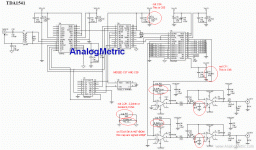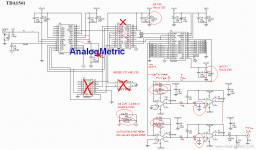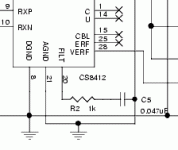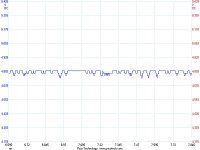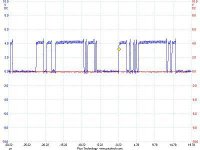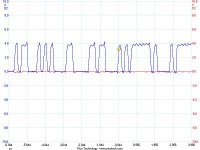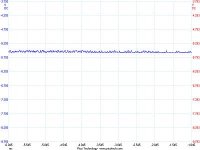I Bought the AnalogMetric TDA1541 Board and i have the CS8412, TDA1541 for an old CD Player.
Does removing the SA7220, 7HC4040 and Clock make the sound any better, does it add extra noise?
How exactly do you remove those so it has no-oversampling or no-reclocking?
I don't want to use opamps in the signal path, i would like to use a tube filter i have 2 6n2p/12ax7's does anybody no the best circuit for this task?
in the datasheet for the cs8412 it says that pin 20 goes to 1K, 0.047uF cap to ground on the board it is not connected, is that ok?
My input to the DAC is the SP/DIF on my Mac Pro / Coax on back of TV
The output of the TDA1541 goes through the tube filter through 10K volume pot and connects directly to the DX Precision I Power Amp.
Does removing the SA7220, 7HC4040 and Clock make the sound any better, does it add extra noise?
How exactly do you remove those so it has no-oversampling or no-reclocking?
I don't want to use opamps in the signal path, i would like to use a tube filter i have 2 6n2p/12ax7's does anybody no the best circuit for this task?
in the datasheet for the cs8412 it says that pin 20 goes to 1K, 0.047uF cap to ground on the board it is not connected, is that ok?
My input to the DAC is the SP/DIF on my Mac Pro / Coax on back of TV
The output of the TDA1541 goes through the tube filter through 10K volume pot and connects directly to the DX Precision I Power Amp.
Attachments
Hello
There is few errors in the Analogmetric TDA1541 DAC schematic.
Look at posts number 89-91-92-93-94 of this thread, there is answers and explanations about those errors:
http://www.diyaudio.com/forums/digital-source/30025-decoupling-tda1541a-9.html
http://www.diyaudio.com/forums/digital-source/30025-decoupling-tda1541a-10.html
Bye
Gaetan
There is few errors in the Analogmetric TDA1541 DAC schematic.
Look at posts number 89-91-92-93-94 of this thread, there is answers and explanations about those errors:
http://www.diyaudio.com/forums/digital-source/30025-decoupling-tda1541a-9.html
http://www.diyaudio.com/forums/digital-source/30025-decoupling-tda1541a-10.html
Bye
Gaetan
I Bought the AnalogMetric TDA1541 Board and i have the CS8412, TDA1541 for an old CD Player.
Does removing the SA7220, 7HC4040 and Clock make the sound any better, does it add extra noise?
How exactly do you remove those so it has no-oversampling or no-reclocking?
I don't want to use opamps in the signal path, i would like to use a tube filter i have 2 6n2p/12ax7's does anybody no the best circuit for this task?
in the datasheet for the cs8412 it says that pin 20 goes to 1K, 0.047uF cap to ground on the board it is not connected, is that ok?
My input to the DAC is the SP/DIF on my Mac Pro / Coax on back of TV
The output of the TDA1541 goes through the tube filter through 10K volume pot and connects directly to the DX Precision I Power Amp.
To bypass the 7220, you need to remove it and then feed the data from pin 26 of the 8412 into pin 3 of the 1541,
connect pin 12 (8412) to 4 of 1541
connect pin 11 (8412) to 2 of 1541
You can leave out the 4040 and xtal as well. The 8412 is configured for I2S out so no need to alter any other pins.
I am using a pair of Sowter transformers to perform I/V conversion and as my JLH power amp has an input impedance of 47k, connecting the transformer secondary direct to it. I might try a valve preamp in between as well.
Try http://lampizator.eu for his valve preamp.
Last edited:
To bypass the 7220, you need to remove it and then feed the data from pin 26 of the 8412 into pin 3 of the 1541,
connect pin 12 (8412) to 4 of 1541
connect pin 11 (8412) to 2 of 1541
You can leave out the 4040 and xtal as well. The 8412 is configured for I2S out so no need to alter any other pins.
I am using a pair of Sowter transformers to perform I/V conversion and as my JLH power amp has an input impedance of 47k, connecting the transformer secondary direct to it. I might try a valve preamp in between as well.
Try Lukasz Fikus Lampizator for his valve preamp.
Didn't spot that M0 on pin 23 of the 8412 needs to be connected to 0v not +5v as shown, (grounding pin 23 switches FCK to output to drive the L/R switch (BCK) input in the 1541)
So to sum up:
8412 1541
Pin 23 to 0v instead of 5v
pin 26 to 3
pin 12 to 4
pin 11 to 2
omit 7220 4040 and xtal.
Don't you mean connect pin 11 (8412) to pin 1 (1541)
thats how it was done in the other NOS circuits
Yes, you are right, brain's not working well today.
Pin 11 (8412) to 1 of 1541
pin 12 to pins 2 and 4 of 1541
pin 26 to pin 3 of 1541
pin 23 to 0v
I
What are the benefits of NOS the 1541 (Is there going to be excessive noise?)
I'll be finding out for myself in a week or so.
I am building a dual differential 1541a dac with transformer I/V conversion and valve output stage. I will no doubt need to experiment with addtional filtering if the nos Audio Note Dac1 kit I had was anything to go by.
SOWTER AUDIO TRANSFORMERS
As for opamp versus valve - you should compare yourself - its personal preference for the sound.
With opamps, filters are easier to implement so I would leave them connected on your dac and just try nos to see if you like the sound.
Then fit transformers between dac and opamp stage and listen again. Then finally try the valve stage.
NOISE ON POWER RAILS & DAC DATA
I bought a couple of old Philips TDA1541 based players off Ebay. A cd471 & cd373.
The attached screenshots from the 471 are of the + 5v and -5v power rails at the 1541 pins.
The +5v rail is only 4.8v and has about .25v of noise on it and the -5v rail is close to -5.6v and also has about .5v of noise on it.
The other screenshots are of the data, before and after the 7220 - ie before and after over sampling.
I don't intend to do anything about the noise as I only bought them as cheap transports with I2S signals for my dual differential dac with I/V transformer experiments.
When I get hold of an analogue scope I will look at the clocks as well (my Pico scope is only good for about 100kHz square wave capture).
I
PS
will upload the +5v screenshot later.
I bought a couple of old Philips TDA1541 based players off Ebay. A cd471 & cd373.
The attached screenshots from the 471 are of the + 5v and -5v power rails at the 1541 pins.
The +5v rail is only 4.8v and has about .25v of noise on it and the -5v rail is close to -5.6v and also has about .5v of noise on it.
The other screenshots are of the data, before and after the 7220 - ie before and after over sampling.
I don't intend to do anything about the noise as I only bought them as cheap transports with I2S signals for my dual differential dac with I/V transformer experiments.
When I get hold of an analogue scope I will look at the clocks as well (my Pico scope is only good for about 100kHz square wave capture).
I
PS
will upload the +5v screenshot later.
Attachments
Last edited:
if u look at the real board the filter pin is connected right.
does anybody know of a really good discrete i/v converter to try?
Try here:
http://www.passdiy.com/pdf/Z-IV.pdf
Its needs to have low input impedance such as common base or common gate.
You should be able to clean up any power supply noise with an LCR filter between the psu and dac.
After reading some posts on this form some people say that the TDA1541 sucks some people say that it sounds really good, how does it compare to the AK4396, PCM19**, and other modern DAC's I'm did not know that building a DAC had so many hard choices to make.
All of the music that I listen to is on my computer in 16-Bit Lossless on my Mac Pro, My Amp is a clone of the DX Precision I, and my speakers are a copy of these The Seas ER18DXT ported two way
I really don't have anything to compare the sound to because I don't have any vinyl of the recordings. and the only other "DAC" like thing i have is a budget Yamaha Receiver with a Pre-Out. What i'm saying is how will I know it sounds "good" if I never heard it without the music passing through something that is "Hi-Fi"
All of the music that I listen to is on my computer in 16-Bit Lossless on my Mac Pro, My Amp is a clone of the DX Precision I, and my speakers are a copy of these The Seas ER18DXT ported two way
I really don't have anything to compare the sound to because I don't have any vinyl of the recordings. and the only other "DAC" like thing i have is a budget Yamaha Receiver with a Pre-Out. What i'm saying is how will I know it sounds "good" if I never heard it without the music passing through something that is "Hi-Fi"
After reading some posts on this form some people say that the TDA1541 sucks some people say that it sounds really good, how does it compare to the AK4396, PCM19**, and other modern DAC's I'm did not know that building a DAC had so many hard choices to make. "
That's the $64000 question and there is no answer. Only you know what you like so there's no point in asking others because you may not like what they do.
In many cases newer chips replace older ones not because they sound better but because they offer more features - eg multiple sample rate capability, multiple inputs etc. I believe the manufacturers are more intent on trying to keep abreast of competitors than offering us better sound quality.
In comparing the 1987 Philips CD471 with my benchmark Musical Fidelty Xray and Xdac, I was bemused to find how the difference between them was not vast and could probably be accounted for by improved design and better quality components rather than a major breakthrough in dac design.
This is why I am pressing ahead with my own dual differential 1541 design.
I will compare it with the Xdac and Audio Note Dac 1 (AD1865 dac) and also try the I/V transformers on the AD1865.
So unless you can experiment, you will never really know what you are missing!
I
First I want to try it with oversampling on to see the difference in SQ I have the SAA7220 can you just place in without the clock and 74HC04 and to put it back in NOS just place the 3 wire links.
I will try OpAmps first than tubes (does anyone have any good tube I/V stages)
Do I need a preamp after the i/v stage or can that plug right into the amp (10K volume-10K impedance amp)?
what is the best way to have a subwoofer output with a 100Hz crossover?
in NOS mode will there be hi-freq rolloff or excessive noise?
I will try OpAmps first than tubes (does anyone have any good tube I/V stages)
Do I need a preamp after the i/v stage or can that plug right into the amp (10K volume-10K impedance amp)?
what is the best way to have a subwoofer output with a 100Hz crossover?
in NOS mode will there be hi-freq rolloff or excessive noise?
in NOS mode will there be hi-freq rolloff or excessive noise?
There will be a little HF rolloff, but most people dont care or dont notice. Only you can see for yourself if it matters or is noticeable to you.
If you leave the filter caps installed, you will be unlikely to percieve any aliasing noise. If you remove them, you might, or might not sometimes notice some strange effects in the mid and highs.
After reading some posts on this form some people say that the TDA1541 sucks some people say that it sounds really good, how does it compare to the AK4396, PCM19**, and other modern DAC's I'm did not know that building a DAC had so many hard choices to make.
The TDA1541A compares very well to modern DAC chips, fear not.
Unlikely to sound betterWould a output stage using the OPA633 have better sound than a tube output stage
does anybody know of a really good discrete i/v converter to try?
Yes, a class A valve output stage, using 6DJ8 or equivilent
What are the benefits of NOS the 1541
IMO, to put it simply, non oversamling avoids the use of the SAA7220 upsampling filter chip in the signal path, which for various reasons, results in "bad" sound.
When this chip is bypassed most people notice an improvement in the sound.
First I want to try it with oversampling on to see the difference in SQ I have the SAA7220 can you just place in without the clock and 74HC04 and to put it back in NOS just place the 3 wire links.
?
Not quite, with this kit, the CS8412 reciever is wired up in slave mode so it takes its clock signals from the Crystal on the board. You have put the CS8412 into Master mode so the clocks are generated internally, so you have to lift one leg of the CS8412 and connect another leg to either ground or +5V (I cant remember now - I will look later tonight and let you know)
Last edited:
- Status
- This old topic is closed. If you want to reopen this topic, contact a moderator using the "Report Post" button.
- Home
- Source & Line
- Digital Source
- Need help with Analogmetric TDA1541 DAC
